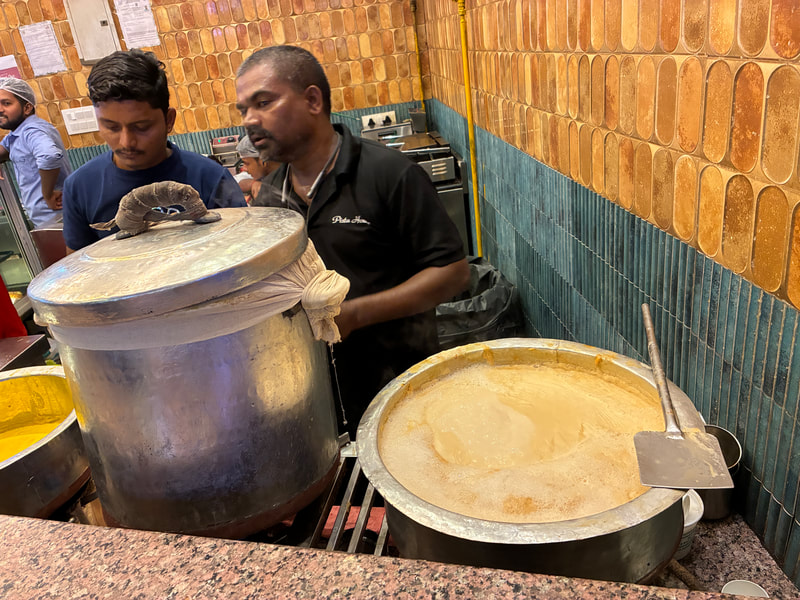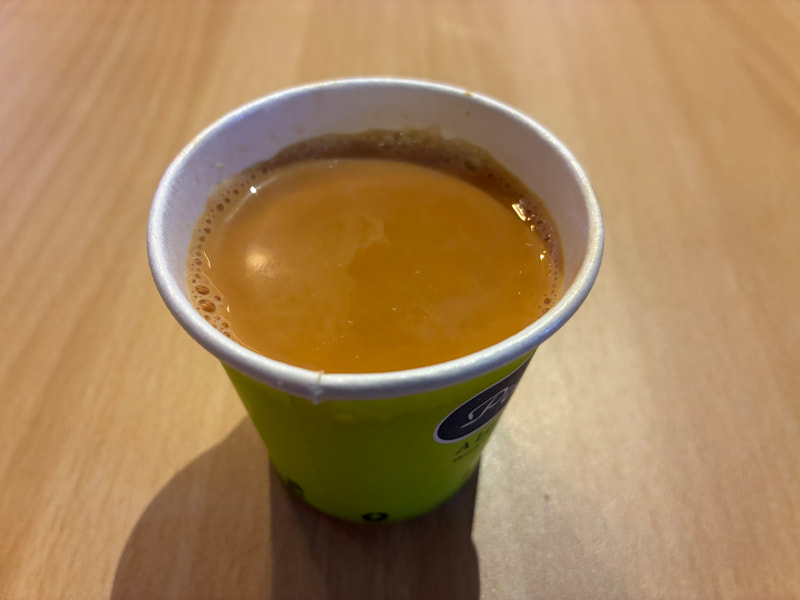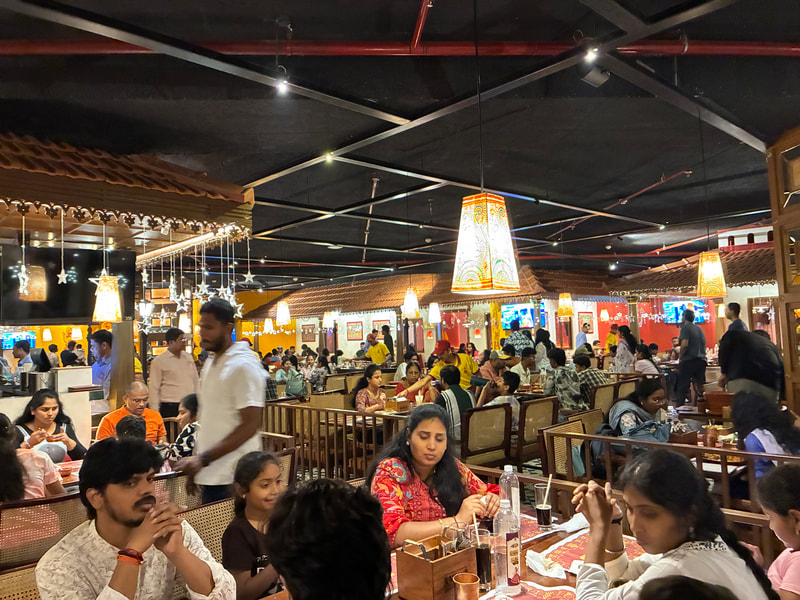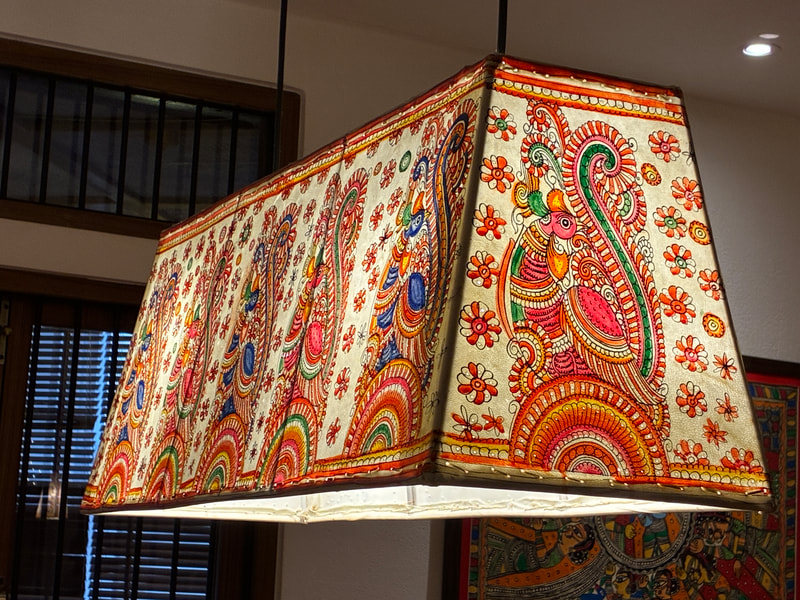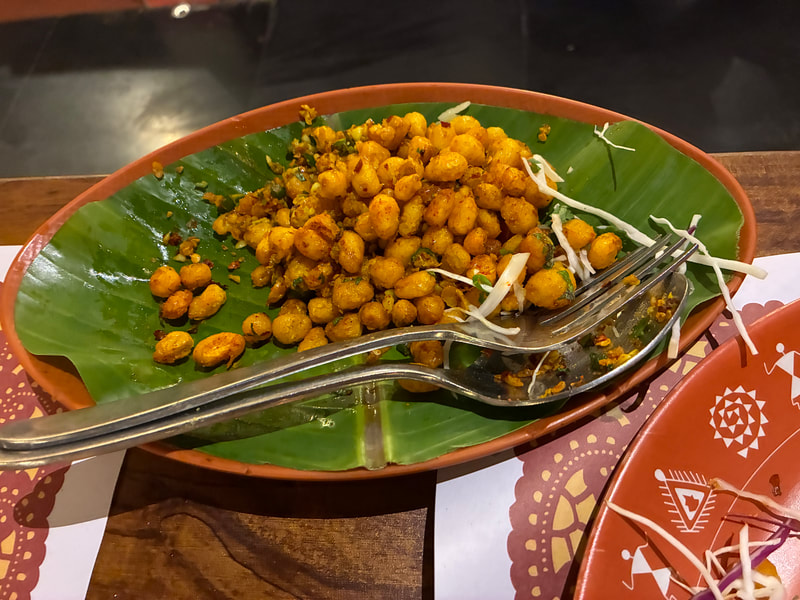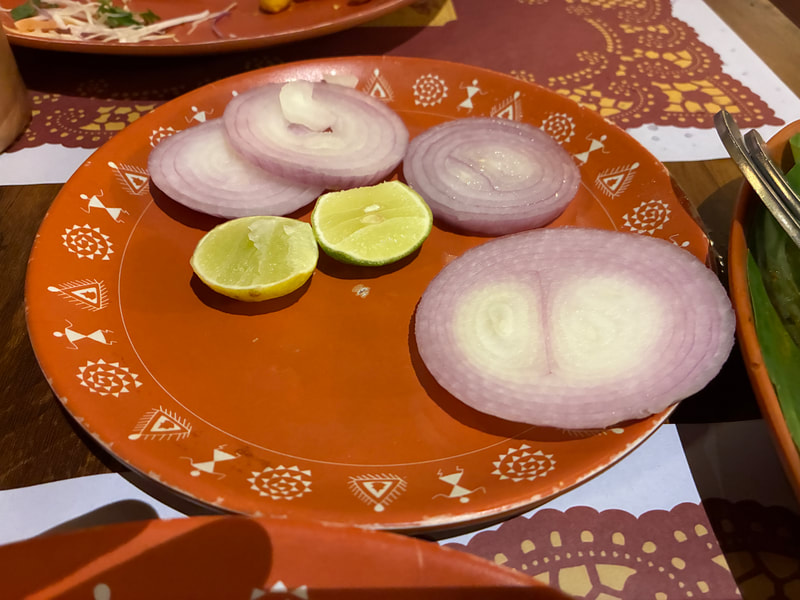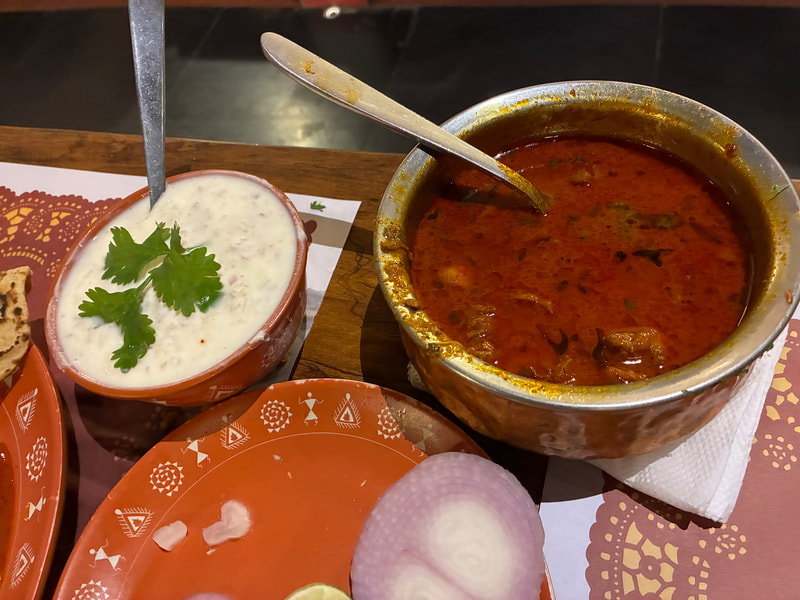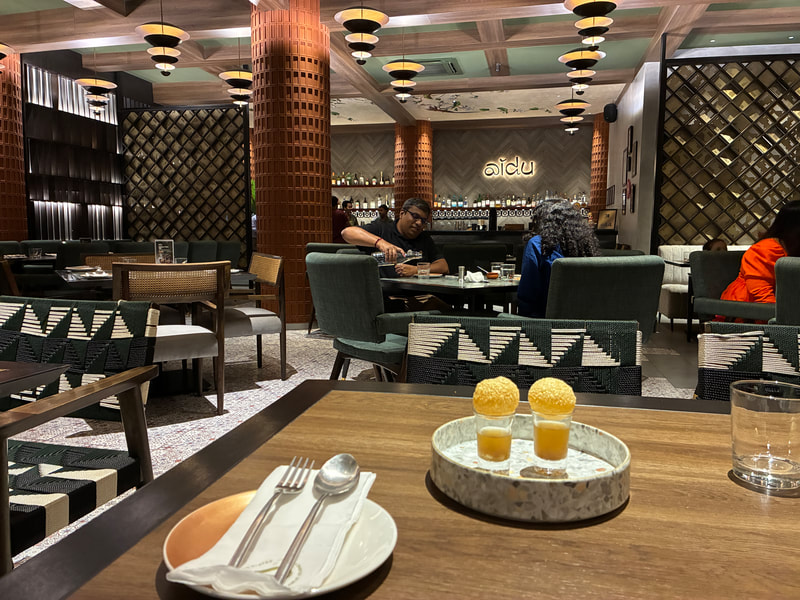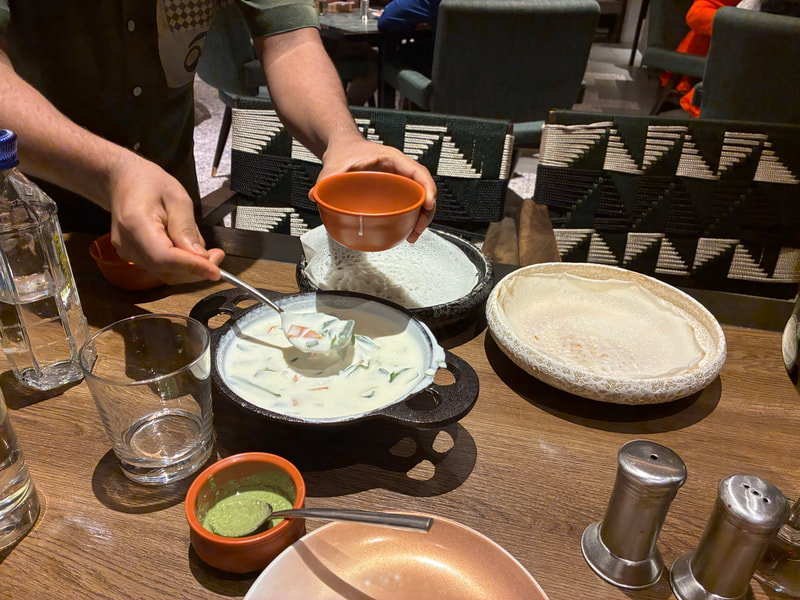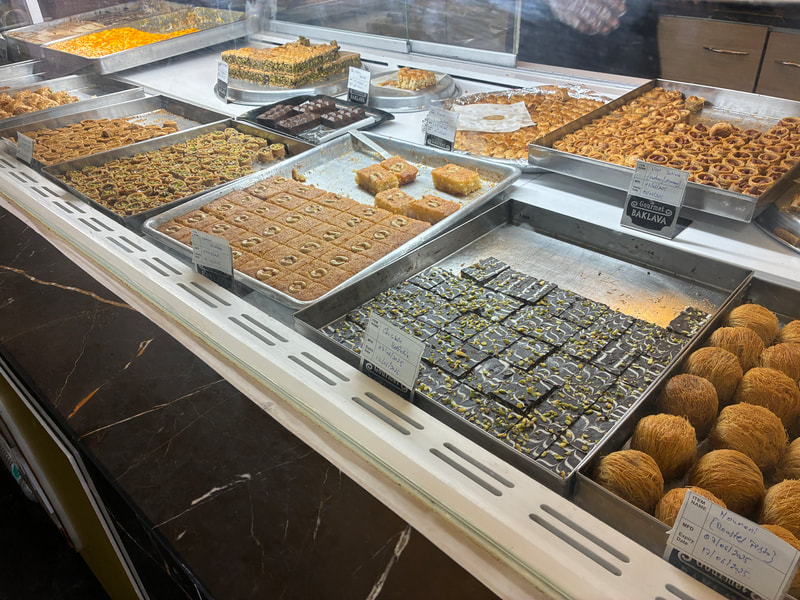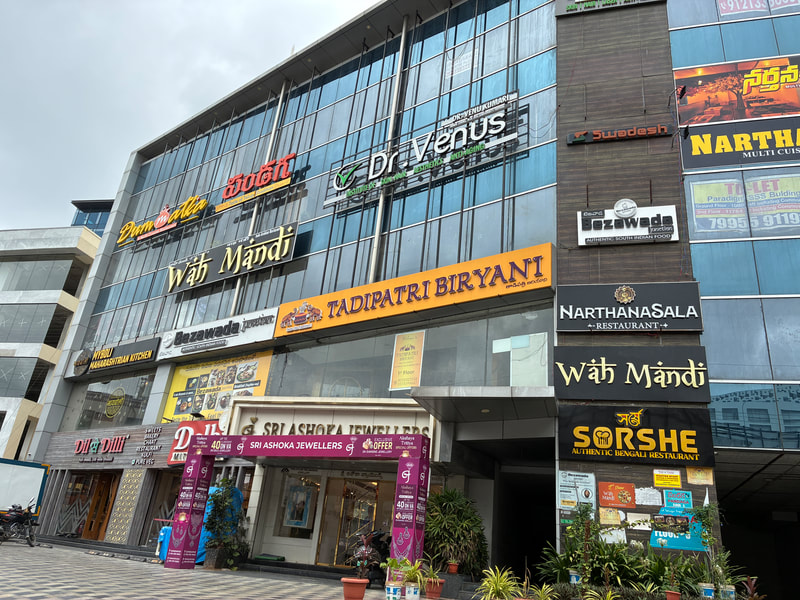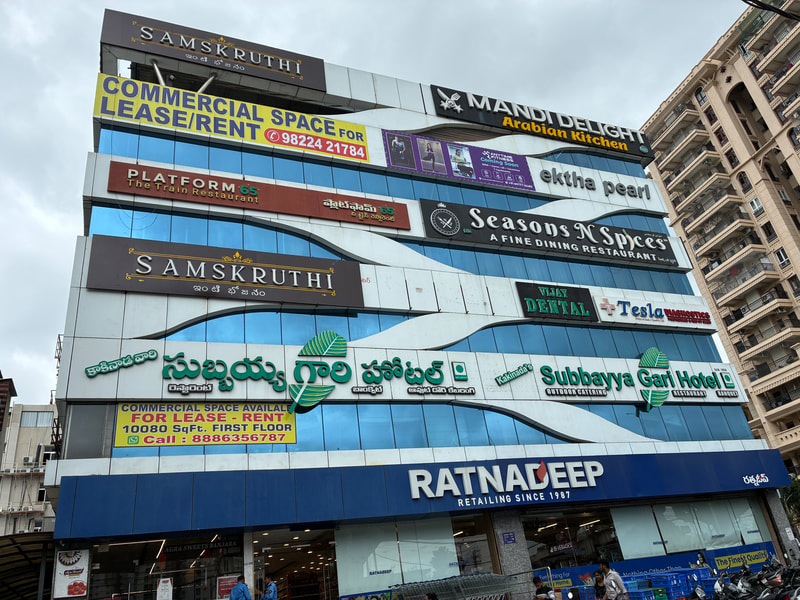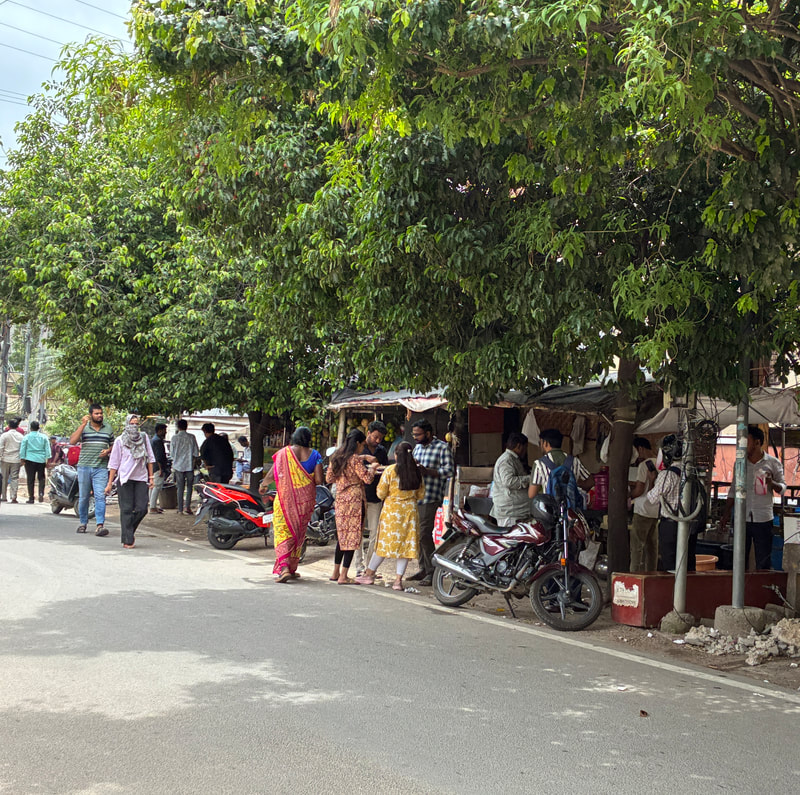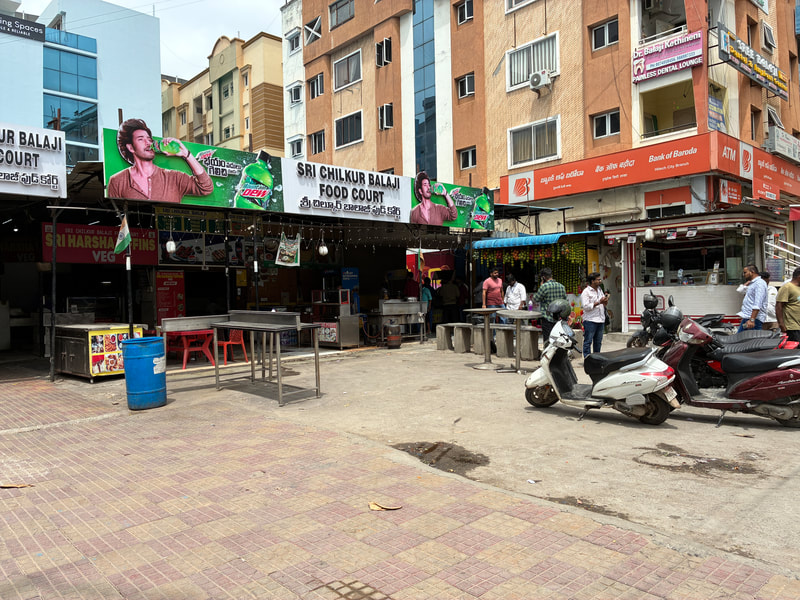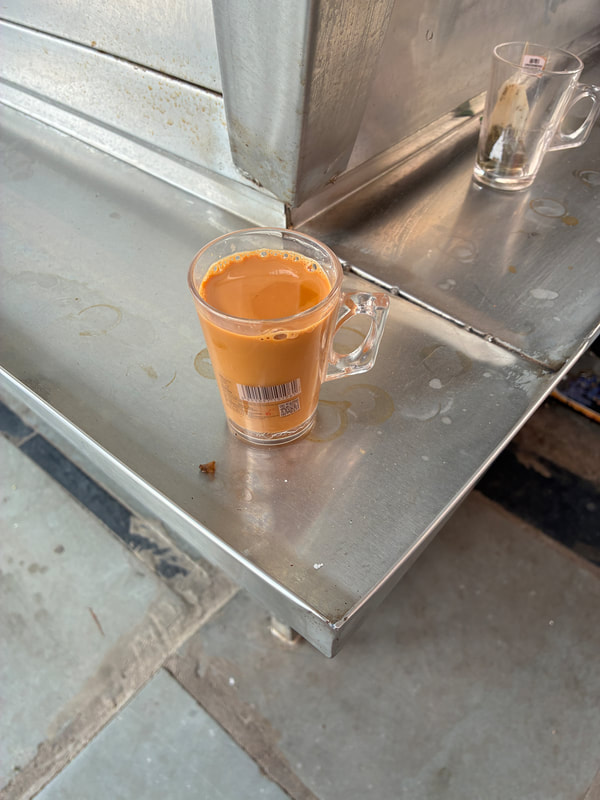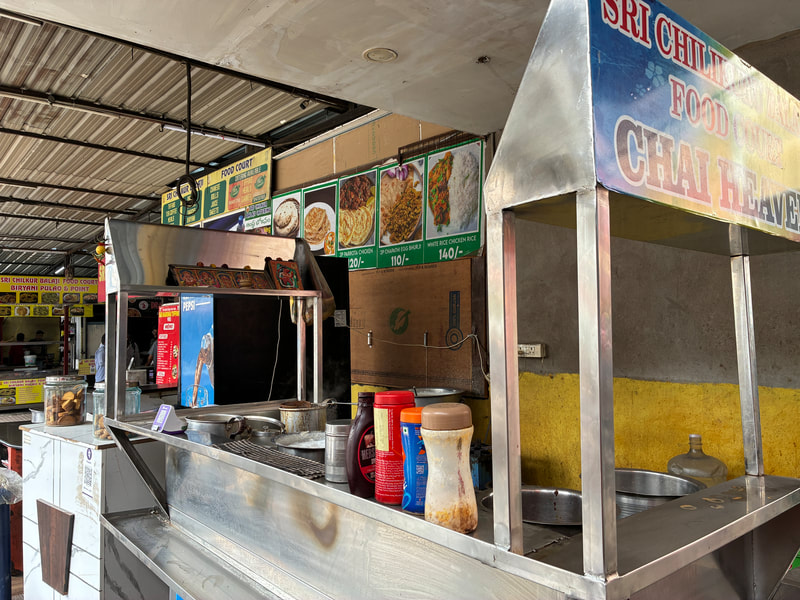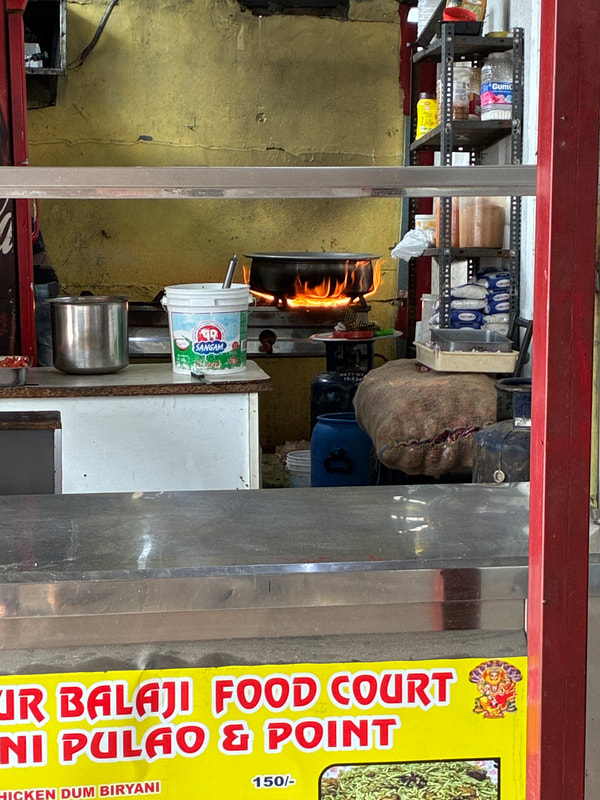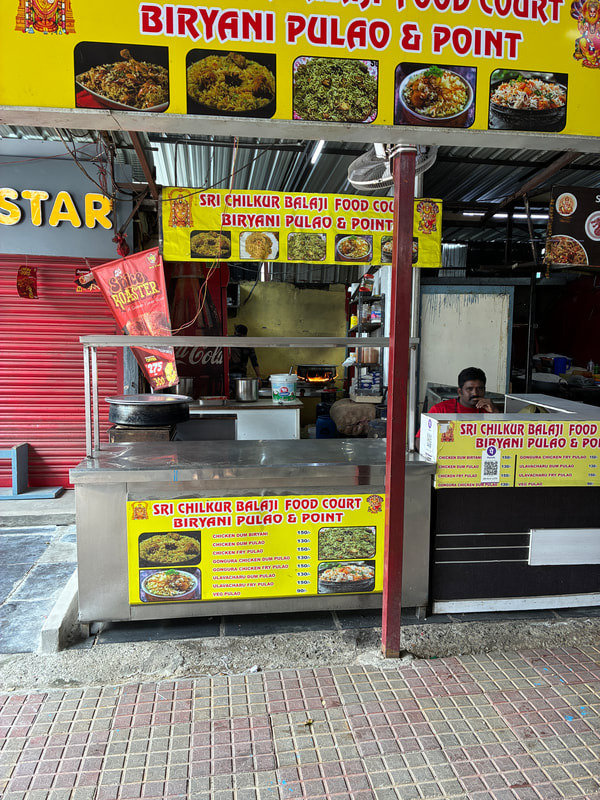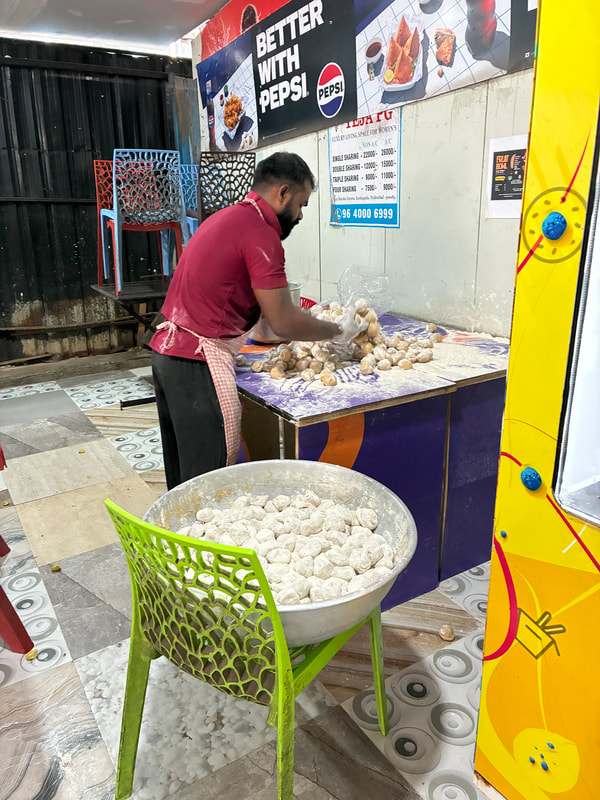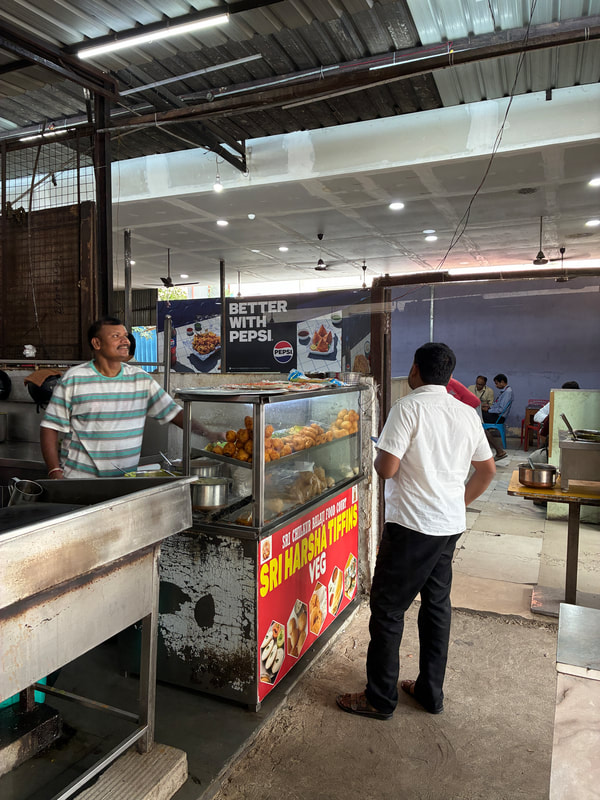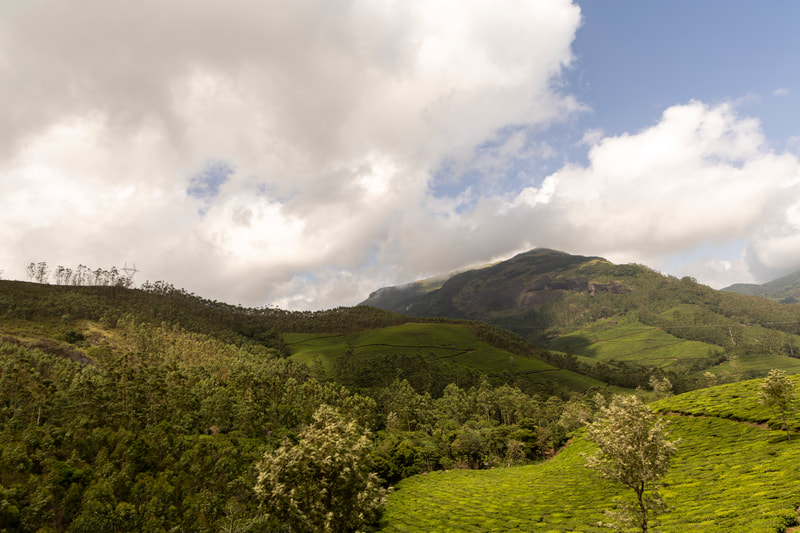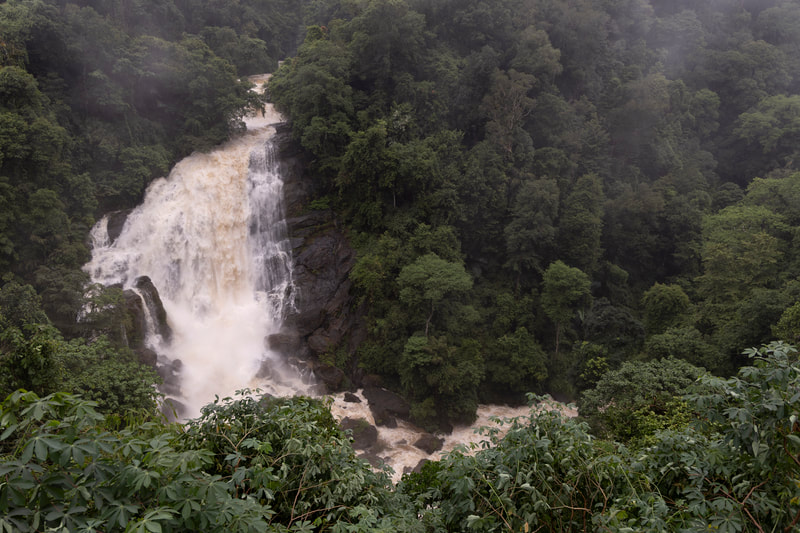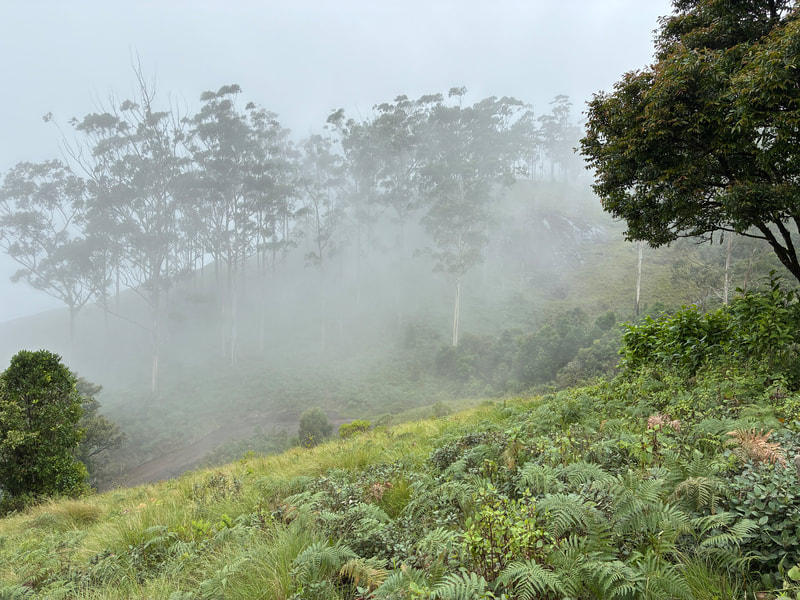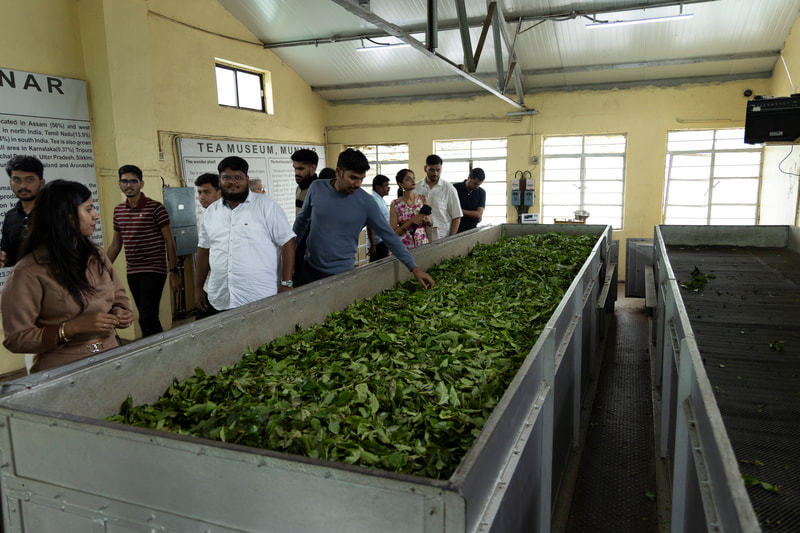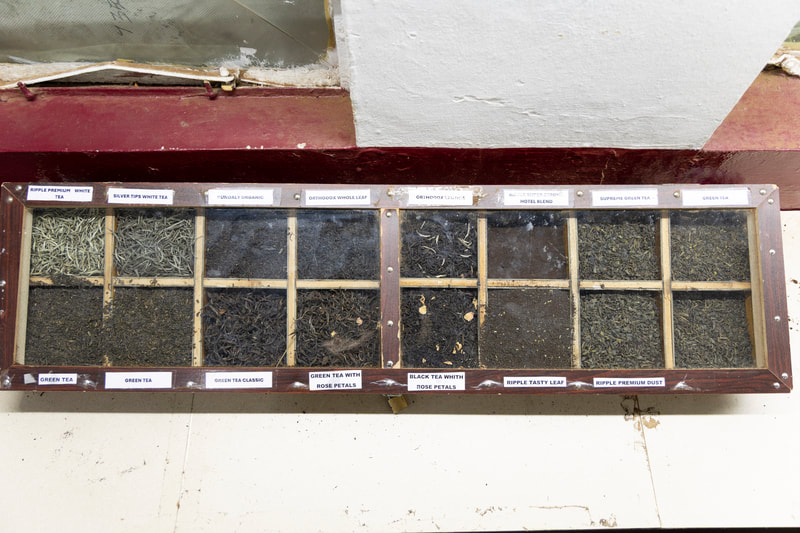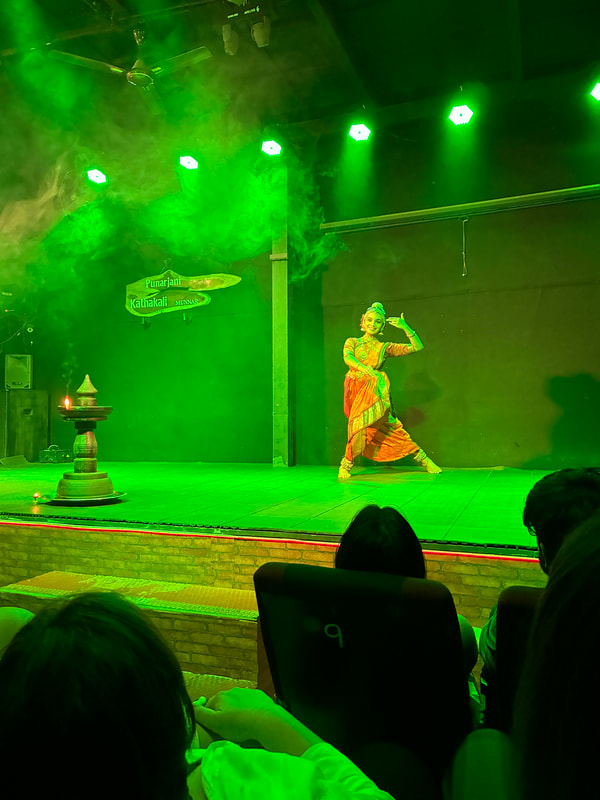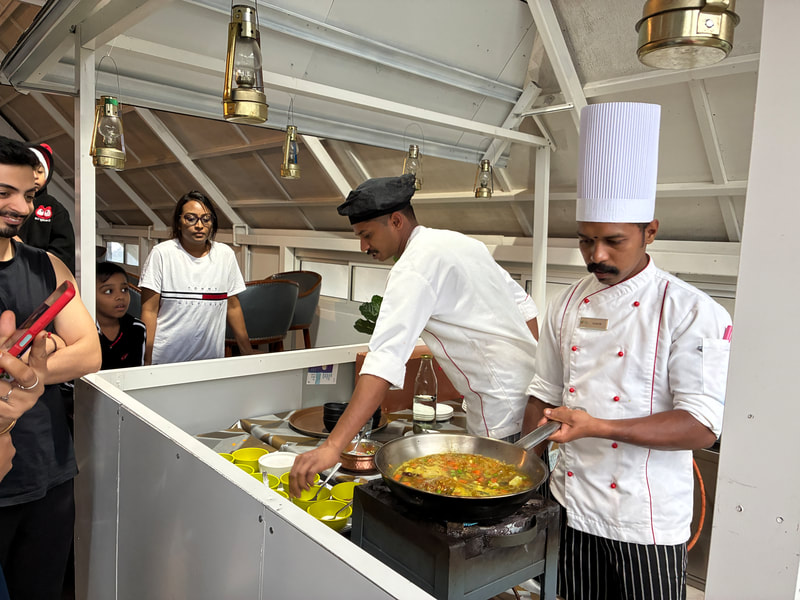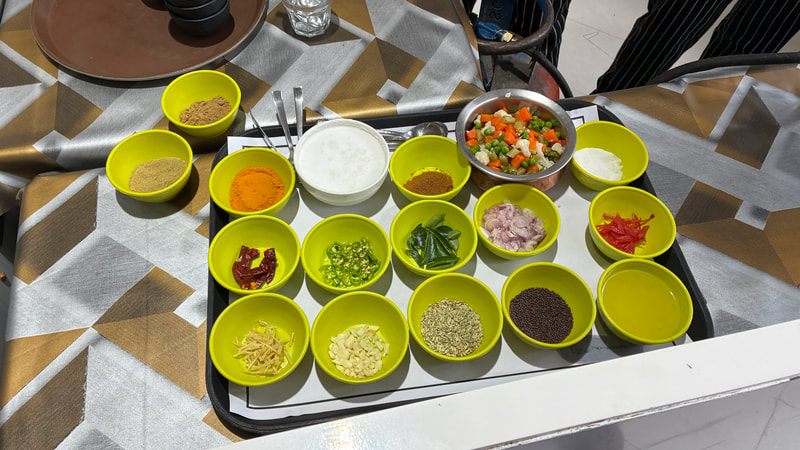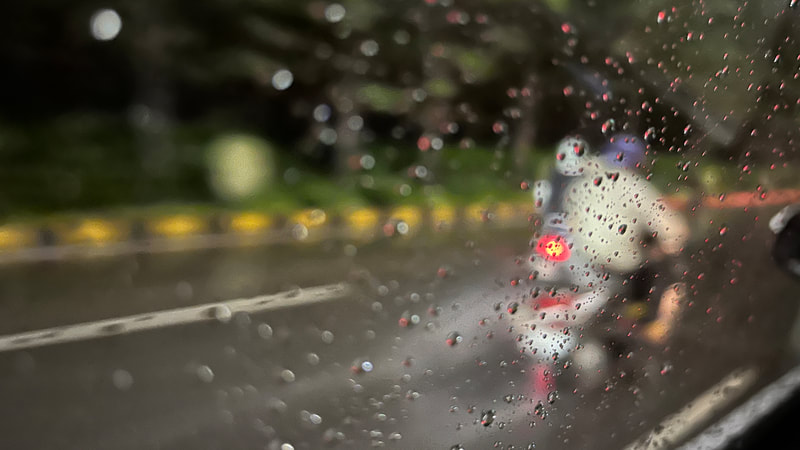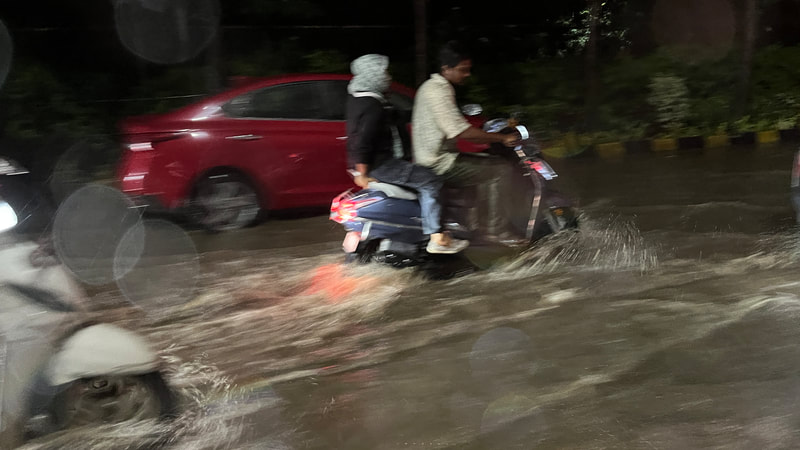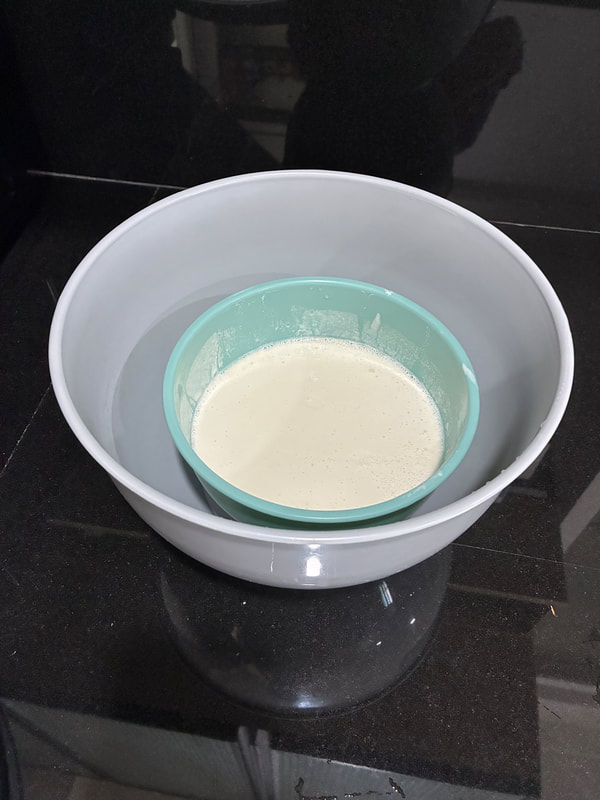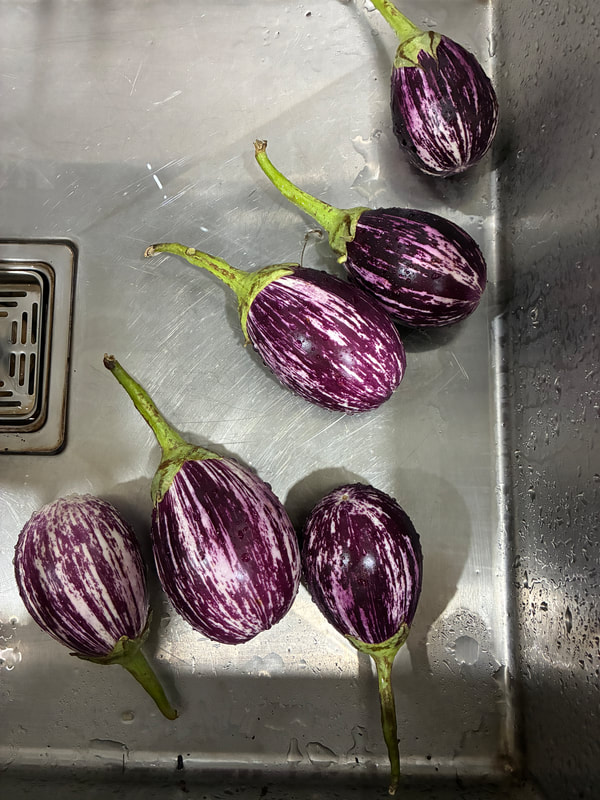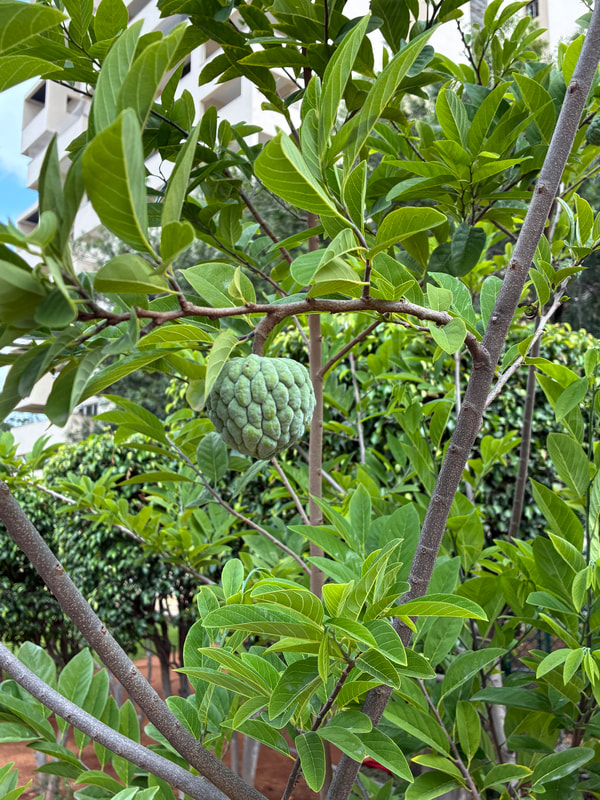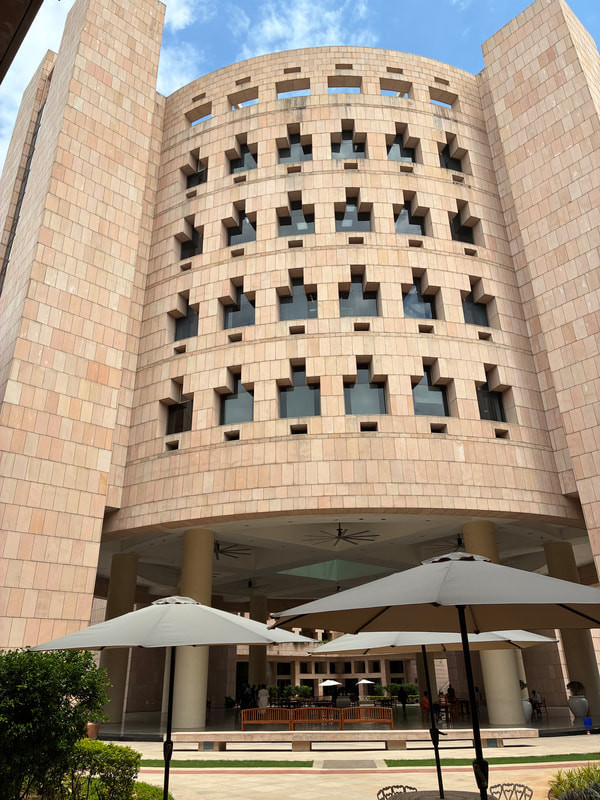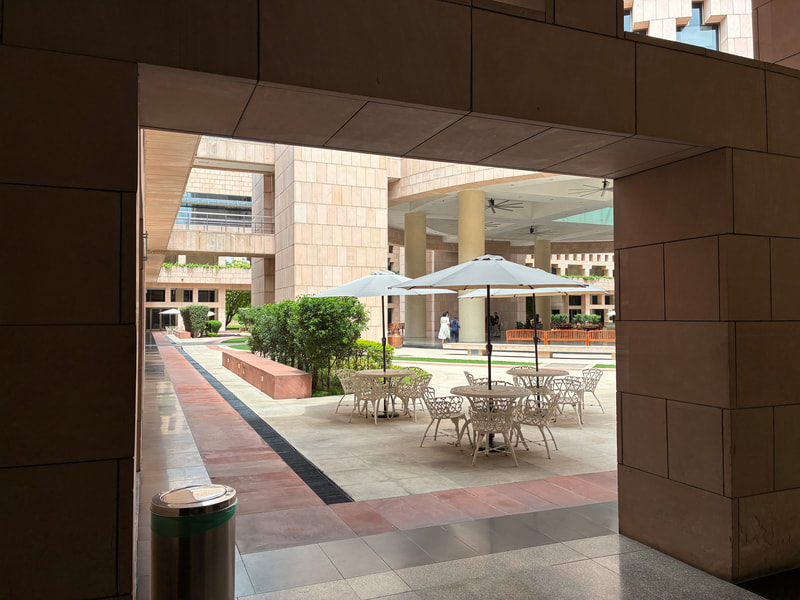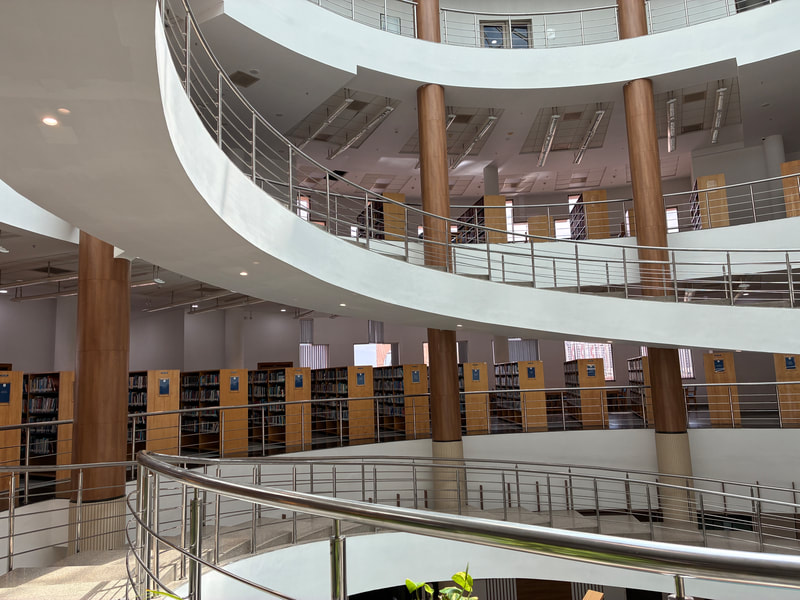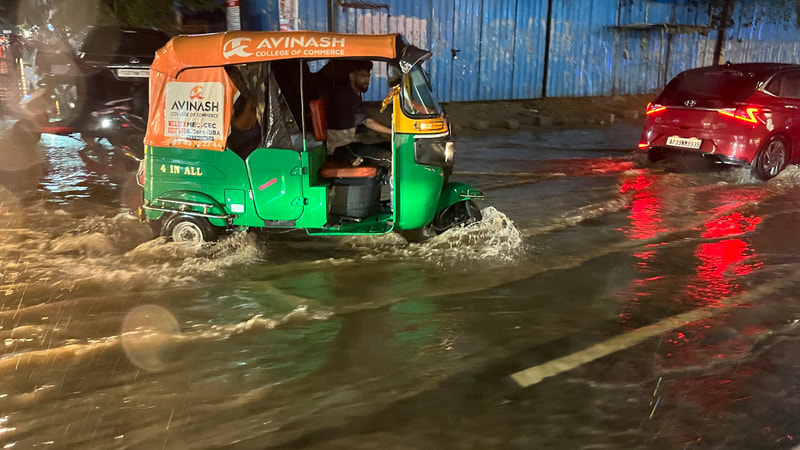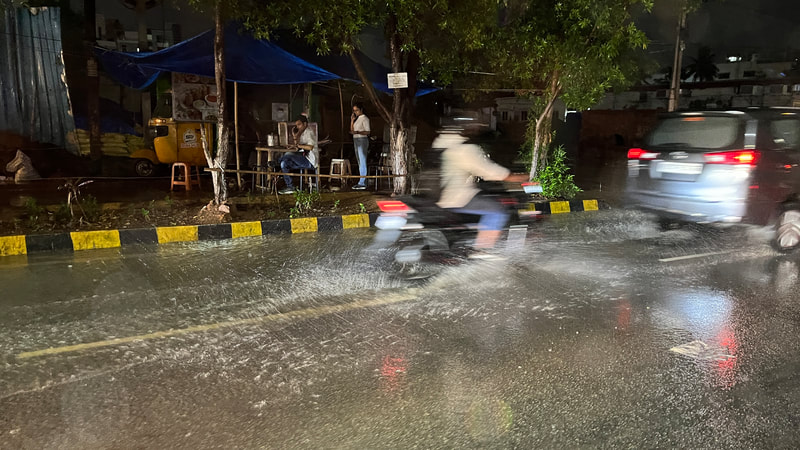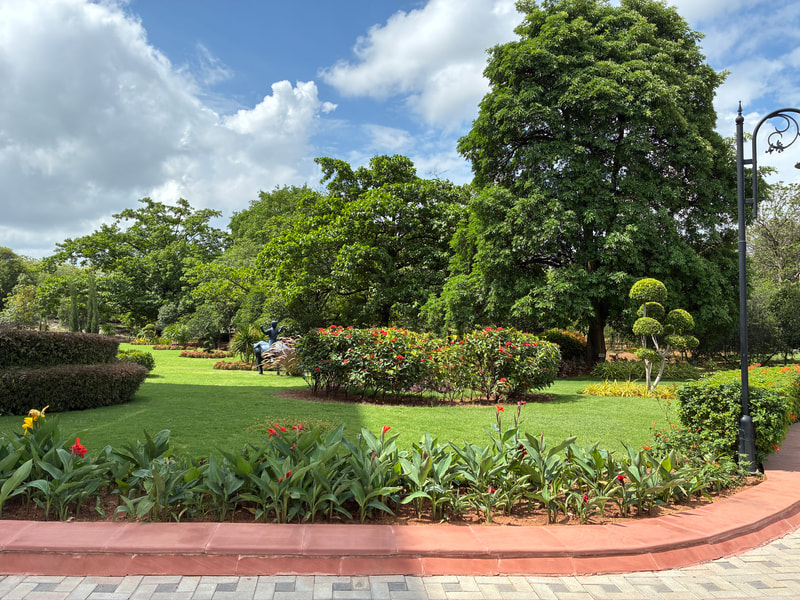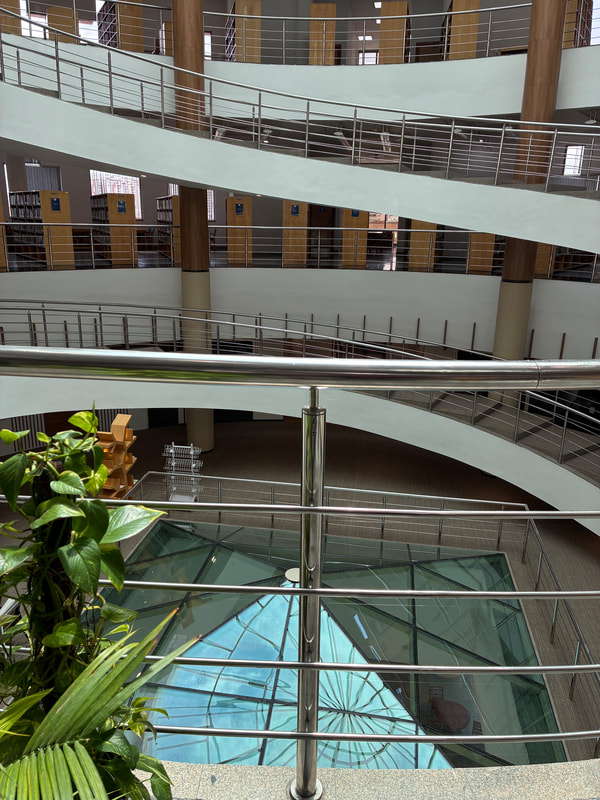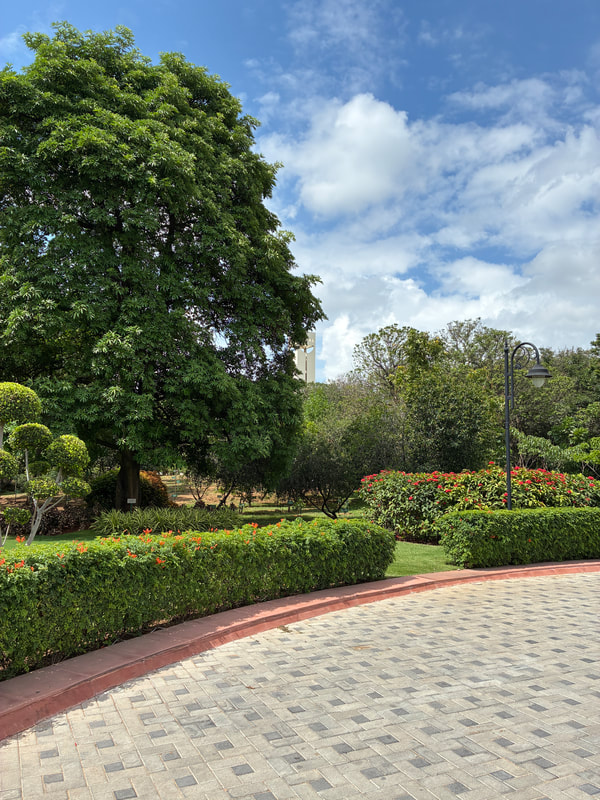|
Our beloved Irani Chai, typical for Hyderabad 😋 Wir essen (und trinken) hier viel mehr auswärts als in der Schweiz. Das hat mehrere Gründe: es ist erschwinglich (auch top Restaurants), spannend (weil wir viel entdecken) und natürlich bequem. Es gibt unendlich viele Beizen, Street Food Ecken, Fast Foods und Restaurants. Die meisten bieten (eine spezifische) indische Küche an. Welche genau ist dann sehr variantenreich, was bei diesem grossen Subkontinent nicht erstaunt. Es gibt süd- und nordindische Küche, das ist mal die grobe Unterscheidung. Dazu kommen lokale Spezialitäten, zum Beispiel das Hyderabader Biryani, oder solche aus ganz anderen Regionen. Wir können typische Speisen aus Goa, Westbengal, Punjab oder aus irgend einem anderen indischen Ort finden. Auch gibt es viele rein vegetarische Restaurants ("pure veg"); das bedeutet dann auch ohne Ei. Natürlich haben wir schon viel probiert, aber wir sind noch lange nicht am Ende der Entdeckungen! Zusätzlich findet man hier Restaurants mit "ausländischem" Essen: pan-asiatisch zum Beispiel, japanisch, italienisch, etc.. Es gibt dabei einige gute, allerdings finden wir relativ oft, dass der Geschmack nicht so ist, wie wir erwarten. Inzwischen haben wir auch hier Entdeckungen gemacht: am spannendsten bis anhin ist ein ausgezeichnetes burmesisches (rein vegetarisch) Restaurant. Da gibt es Speisen, die ich vorher noch nie probiert habe. Im (indischen) Restaurant gilt, dass die Speisen mit allen am Tisch geteilt werden. Wenn man das nicht möchte, muss man es sagen. Ausserdem wird man immer bedient, zumindest wenn das Essen gebracht wird. Die Portionen sind oft sehr gross und werden in Schalen oder auf Platten serviert, die auf dem Tisch bleiben. Die Mengen, die auf den Teller geschöpft werden, sind eher klein. Man isst oft mit dem Löffel oder mit der rechten Hand - ja, wir auch 😉. Wer mit der Hand isst, kann die Zutaten sehr gut mischen, und es gibt einem eine zusätzliche taktile Erfahrung. Das gilt für Reisgerichte oder wenn man ein Gericht mit indischem (also flachem) Brot isst. Ich habe einen Moment gebraucht, aber jetzt esse ich gewisse Speisen sehr gern mit der Hand. Wir haben gelernt, nicht zu viel aufs Mal zu bestellen. Das hat mehrere Gründe: wir möchten nicht alles gleichzeitig bekommen, wir können so die Mengen besser einschätzen und das Timing beeinflussen. We eat (and drink) out much more here than in Switzerland. There are several reasons for this: it's affordable (including top restaurants), exciting (because we discover a lot) and of course convenient. There are countless pubs, street food corners, fast food outlets and restaurants. Most of them offer (a specific) Indian cuisine. Which one exactly is very varied, which is not surprising for this large subcontinent. There is South and North Indian cuisine, that's the rough distinction. There are also local specialities, such as biryani from Hyderabad, or dishes from completely different regions. We can find typical dishes from Goa, West Bengal, Punjab or any other Indian place. There are also many purely vegetarian restaurants (‘pure veg’), which means without eggs. Of course, we have already tried a lot, but we are still far from the end of our discoveries! You can also find restaurants with ‘foreign’ food here: pan-Asian, for example, Japanese, Italian, etc.. There are some good ones, but we often find that the flavour is not what we expect. In the meantime, we have also made some discoveries here: the most exciting so far is an excellent Burmese (purely vegetarian) restaurant. There are dishes there that I have never tried before. In (Indian) restaurants, food is shared with everyone at the table. If you don't want this, you have to say so. In addition, you are always served, at least when the food is brought. The portions are often very large and are served in bowls or on plates that remain on the table. The quantities that are scooped onto the plate are rather small. People often eat with a spoon or with their right hand - yes, we do too 😉. Eating by hand allows you to mix the ingredients very well and gives you an additional tactile experience. This applies to rice dishes or when eating a dish with Indian (i.e. flat) bread. It took me a moment, but now I really enjoy eating certain dishes by hand. We have learnt not to order too much at once. There are several reasons for this: we don't want to get everything at the same time, we can better estimate the quantities and influence the timing. Translated with DeepL.com (free version) En bas: deux restaurants élégants - et on nous sert donc toujours la nourriture à la table. Nous mangeons (et buvons) beaucoup plus à l'extérieur ici qu'en Suisse. Il y a plusieurs raisons à cela : c'est abordable (même les meilleurs restaurants), passionnant (parce que nous découvrons beaucoup de choses) et bien sûr pratique. Il y a un nombre infini de bistrots, de coins de street food, de fast foods et de restaurants. La plupart d'entre eux proposent une cuisine indienne (spécifique). Laquelle est très variée, ce qui n'est pas étonnant pour ce grand sous-continent. Il y a la cuisine du sud et celle du nord de l'Inde, c'est la première distinction. S'y ajoutent des spécialités locales, par exemple le biryani d'Hyderabad, ou des plats d'autres régions. Nous pouvons trouver des plats typiques de Goa, du Bengale occidental, du Punjab ou de tout autre endroit indien. Il existe également de nombreux restaurants purement végétariens (« pure veg »), ce qui signifie sans œufs. Bien sûr, nous avons déjà goûté beaucoup de choses, mais nous sommes loin d'être au bout de nos découvertes ! De plus, on trouve ici des restaurants proposant de la nourriture « étrangère » : pan-asiatique par exemple, japonaise, italienne, etc. Il y en a de bons, mais nous trouvons assez souvent que le goût n'est pas celui que nous attendions. Entre-temps, nous avons également fait des découvertes dans ce domaine : le plus passionnant jusqu'à présent est un excellent restaurant birman (entièrement végétarien). Il y a des plats que je n'avais jamais goûtés auparavant. Au restaurant (indien), la règle veut que les plats soient partagés avec tout le monde à table. Si on ne le souhaite pas, il faut le dire. En outre, on est toujours servi, du moins au moment où la nourriture est apportée à table. Les portions sont souvent très grandes et sont servies dans des bols ou sur des plats qui restent sur la table. Les quantités servies dans l'assiette sont plutôt petites. On mange souvent avec une cuillère ou avec la main droite - oui, nous aussi 😉. Quand on mange avec la main, on peut très bien mélanger les ingrédients et cela nous donne une expérience tactile supplémentaire. C'est le cas pour les plats de riz ou quand on mange un plat avec du pain indien (donc plat). Cela m'a pris un peu de temps, mais maintenant j'aime beaucoup manger certains plats avec la main.
Nous avons appris à ne pas commander trop de choses à la fois. Il y a plusieurs raisons à cela : nous ne voulons pas tout avoir en même temps, nous pouvons ainsi mieux évaluer les quantités et influencer le timing. Traduit avec DeepL.com (version gratuite)
1 Comment
Letztes Wochenende waren wir in Munnar in Kerala. Yashi hat den Freitag frei genommen und am Montag war ein Feiertag, also hatten wir vier Tage Zeit. Ich habe lange gesucht, bis ich einen Ort gefunden habe, wo keine hochsommerlichen Temperaturen herrschen und den ich Lust hatte zu bereisen. Meine Wahl ist auf Munnar in Kerala gefallen (unser Sohn hat diesen Ort besucht und empfohlen). Als ich einem befreundeten Ehepaar davon erzählt habe, hat dieses sich kurzentschlossen entschieden mitzukommen. Munnar ist auf 1700 m Höhe, in Südindien. Der höchste indische Berg, der nicht im Himalaya ist, befindet sich dort. Es gibt auch viele Teeplantagen. Die Berglandschaft fühlt sich für uns relativ vertraut an, nicht extrem hoch und eher hügelig, sehr grün und in unserem Fall auch regnerisch (v.a. an unserem Anreisetag). Allerdings ist die Vegetation und die Fauna ganz anders, da wir uns in einem subtropischen Hochland befinden. Es fühlt sich für mich nach Regenwald an: üppiges, dunkles und dichtes Grün, Affen am Strassenrand, Bananenstauden und viele Kokospalmen. Wir waren im Teemuseum, wo wir nach unseren Erfahrungen in Darjeeling einiges wieder gehört, aber auch Neues dazu gelernt haben. Die Plantage, auf der dieses Museum steht, gehört inzwischen einem Teil der Mitarbeitenden (denjenigen, die dort gearbeitet haben, als die Tata-Gruppe die Plantage verkauft hat). Das bedeutet, dass sie wie eine Genossenschaft funktioniert - das hat uns sehr gefallen. Dann haben wir einen Nationalpark besucht und dort einen Spaziergang gemacht. Die Landschaft ist sehr schön und unsere Freunde waren super beeindruckt. Sie kommen aus Australien und haben noch nie so eine Berglandschaft gesehen. Ein paar Nilgiri Tahrs (sieht aus wie eine Art Steinbock, ist aber offenbar eher mit dem Schaf verwandt) haben sich gezeigt, eines hat uns sogar beschnuppert - wollte wohl etwas zu fressen. Abends haben wir noch je eine lokale Tanz- und eine Kampfkunstvorführung besucht. Das war interessant und sehr unterhaltsam, v.a. die Kampfkunst. Abgesehen von diesen Ausflügen haben wir unser wunderschönes Hotel ausgenützt und entspannt. Die An- und Abreise haben je einen Tag beansprucht, so haben wir doch einen Teil von Kerala sehen können. Foodrubrik: Zwei der Hotelköche haben uns gezeigt, wie sie eines der typischen lokalen Gerichte kochen: ein Malabar Gemüsecurry. In Kerala isst man etwas weniger scharf. Es werden Kokosöl und auch viel Kokosmilch benützt. Bei den Gewürzen ist mir aufgefallen, dass sie nicht Kümmel sondern Fenchelsamen genommen haben. Ich glaube, das ist das erste indische Rezept ohne Kümmel, das ich gesehen und gegessen habe 😂. Abgesehen davon, haben sie ca. 15 Gewürze in den Curry gemischt, wie immer in Indien; ein Teil wird angebraten, ein anderer später reingemischt. Das ergibt schon sehr unterschiedliche Geschmäcke. Auf jeden Fall hat uns das Gemüsecurry geschmeckt. Am nächsten Tag jedoch gab es einen Fisch-Malabar-Curry beim Buffet. Den habe ich sensationell gefunden. Die Sauce hatte wieder Kokosmilch, aber auch Zitronensaft. Diese Mischung funktioniert super gut mit Fisch 😋. Last weekend we were in Munnar in Kerala. Yashi took Friday off and Monday was a public holiday, so we had four days. I searched for a long time until I found a place that didn't have midsummer temperatures and that I felt like travelling to. My choice fell on Munnar in Kerala (our son had visited and recommended this place). When I told friend of ours about it, they decided to come with us. Munnar is at an altitude of 1700 metres in southern India. The highest Indian mountain that is not in the Himalayas is located there. There are also many tea plantations. The mountain landscape feels relatively familiar to us, not extremely high and rather hilly, very green and in our case also rainy (especially on our day of arrival). However, the vegetation and fauna are completely different, as we are in a subtropical highland. It feels like a rainforest to me: lush, dark and dense greenery, monkeys by the roadside, banana trees and lots of coconut palms. We went to the tea museum, where we learnt some new things as well as hearing some knowns after our experiences in Darjeeling. The plantation on which this museum is located is now owned by some of the employees (those who worked there when the Tata Group sold the plantation). This means that it works like a co-operative - we really liked that. Then we visited a national park and went for a walk there. The landscape is very beautiful and our friends were super impressed. They are from Australia and have never seen a mountain landscape like this before. A few Nilgiri tahrs (looks like a kind of ibex, but is apparently more related to sheep) showed themselves, one even sniffed at us - probably wanted something to eat. In the evening, we attended a local dance and a martial arts performance. It was interesting and very entertaining, especially the martial arts. Apart from these excursions, we made the most of our wonderful hotel and relaxed. Travelling to and from the hotel took a day each, so we were able to see a part of Kerala. Food section: Two of the hotel chefs showed us how they cook one of the typical local dishes: a Malabar vegetable curry. In Kerala, the food is a little less spicy. They use coconut oil and a lot of coconut milk. When it came to spices, I noticed that they didn't use cumin but fennel seeds. I think this is the first Indian recipe without cumin that I have seen and eaten 😂. Apart from that, they mixed about 15 spices into the curry, as they always do in India; one part is fried, another is mixed in later. This results in very various flavours. In any case, we enjoyed the vegetable curry. The next day, however, we had a fish Malabar curry at the buffet. I found it sensational. The sauce had coconut milk again, but also lemon juice. This mixture works really well with fish 😋. Le week-end dernier, nous sommes allés à Munnar, dans le Kerala. Yashi a pris congé le vendredi et le lundi était un jour férié, nous avons donc eu quatre jours de congés. J'ai cherché longtemps avant de trouver un endroit où les températures ne sont pas super chaudes et que j'avais envie de visiter. Mon choix s'est porté sur Munnar, dans le Kerala, car c'est un endroit que notre fils avait visité et recommandé. Lorsque j'en ai parlé à un couple d'amis, ils ont décidé de se joindre à nous. Munnar se trouve à 1700 mètres d'altitude, dans le sud de l'Inde. La plus haute montagne indienne, qui ne se trouve pas dans l'Himalaya, s'y dresse. On y trouve également de nombreuses plantations de thé. Le paysage montagneux nous semble relativement familier, pas extrêmement raide, plutôt vallonné, très vert, et, dans notre cas, également pluvieux (surtout le jour de notre arrivée). Cependant, la végétation et la faune sont très différentes, car nous nous trouvons dans un haut-plateau subtropical. On dirait une forêt tropicale : une verdure luxuriante, sombre et dense, des singes au bord de la route, des bananiers et beaucoup de cocotiers.
Nous sommes allés au musée du thé, où nous avons réentendu certaines choses après notre expérience à Darjeeling, mais où nous avons aussi appris de nouvelles choses. La plantation sur laquelle se trouve ce musée appartient désormais à une partie des collaborateurs (ceux qui y travaillaient lorsque le groupe Tata a vendu la plantation). Cela signifie qu'elle fonctionne comme une coopérative - ce qui nous a beaucoup plu. Ensuite, nous avons visité un parc national et nous y avons fait une promenade. Le paysage est très beau et nos amis ont été super impressionnés. Ils viennent d'Australie et n'ont jamais vu un tel paysage de montagne. Quelques Nilgiri Tahrs (qui ressemblent à une sorte de bouquetin, mais qui sont apparemment plus proches du mouton) se sont montrés, l'un d'eux nous a même reniflés - il voulait sans doute quelque chose à manger. Le soir, nous avons assisté à une démonstration de danse locale et d'arts martiaux. C'était intéressant et très divertissant, surtout les arts martiaux. En dehors de ces excursions, nous avons profité de notre magnifique hôtel et nous nous sommes détendus. Le voyage aller et retour ont pris chacun une journée, ce qui nous a permis de voir une partie du Kerala. Rubrique bouffe : Deux des cuisiniers de l'hôtel nous ont montré comment ils cuisinent l'un des plats locaux typiques : un curry de légumes Malabar. Au Kerala, on mange un peu moins épicé. On utilise de l'huile de coco et beaucoup de lait de coco. Pour les épices, j'ai remarqué qu'ils n'ont pas utilisé de cumin mais des graines de fenouil. Je crois que c'est la première recette indienne sans cumin que j'ai vue et mangée 😂. À part ça, ils ont mélangé une quinzaine d'épices dans le curry, comme toujours en Inde ; une partie est saisie, une autre est mélangée plus tard. Cela donne des goûts très différents. En tout cas, nous avons apprécié le curry. Le lendemain, le buffet proposait un curry de poisson malabar. Je l'ai trouvé sensationnel. La sauce contenait à nouveau du lait de coco, mais aussi du jus de citron. Ce mélange fonctionne super bien avec le poisson 😋. Traduit avec DeepL.com (version gratuite) Ein persönlicher Blick auf elektrische Installationen in der Schweiz und in Indien Vor kurzem stand in unserem Haus in der Schweiz eine obligatorische elektrische Sicherheitskontrolle an – nach 20 Jahren, wie es das Gesetz verlangt. Eine sinnvolle Vorschrift, ohne Zweifel, denn Elektrizität ist nicht nur nützlich, sondern kann auch gefährlich sein, wenn sie nicht korrekt installiert oder gewartet wird. Und dennoch war ich nach der Kontrolle leicht frustriert. Nicht etwa, weil gravierende Mängel entdeckt wurden, sondern weil kleine, für mich eher banale Punkte beanstandet wurden. So zum Beispiel eine Deckenlampe, deren Abdeckung nicht ganz bündig zur Decke montiert ist. Oder ein Verlängerungskabel in der Garage, das durch eine fixe Steckdose ersetzt werden muss. Formal korrekt – keine Frage. Aber der Aufwand und die Kosten zur Behebung stehen für mich in keinem Verhältnis zum tatsächlichen Risiko. Hier in Indien ist die Welt der Elektroinstallationen eine ganz andere. Kabel werden zum Teil offen an Fassaden verlegt, hängen lose aus Mauern oder sind gar nicht angeschlossen. In manchen Haushalten wird improvisiert, auf kreative, manchmal auch abenteuerliche Weise. Es gibt kaum Kontrollen, keine flächendeckenden Normen – aber dafür viel Flexibilität. Man arrangiert sich mit dem, was da ist. Was mich fasziniert: Trotz der offensichtlich weniger strengen Regeln scheint der Alltag zu funktionieren. Es brennt Licht, die Ventilatoren drehen sich, die Waschmaschinen laufen. Natürlich birgt das Risiken – ein Bewusstsein für Sicherheit ist auch hier wichtig. Aber der entspannte Umgang mit kleinen „Unschönheiten“ oder pragmatischen Lösungen ist etwas, das ich schätzen gelernt habe. Was ich mir wünsche, ist nicht weniger Sicherheit – sondern etwas mehr Augenmaß. In der Schweiz haben wir Normen, die weltweit zu den strengsten gehören. Sie sorgen für ein hohes Maß an Schutz, aber sie erzeugen auch Aufwand – finanziell und emotional. Eine etwas gelassenere Haltung bei kleineren, nicht sicherheitsrelevanten Mängeln könnte viel Druck aus dem System nehmen, ohne dass die Sicherheit wesentlich leidet. Denn am Ende geht es doch darum: Technik soll unser Leben erleichtern – nicht unnötig komplizieren. A personal look at electrical installations in Switzerland and India Recently, our house in Switzerland was due for a mandatory electrical safety check - after 20 years, as required by law. A sensible regulation, no doubt, because electricity is not only useful but can also be dangerous if it is not installed or maintained correctly. And yet I was slightly frustrated after the inspection. Not because serious defects were discovered, but because small, for me rather trivial points were criticised. For example, a ceiling light with a cover that wasn't quite flush with the ceiling. Or an extension cable in the garage that needs to be replaced by a fixed socket. Formally correct - no question. But for me, the effort and costs involved in rectifying the problem are disproportionate to the actual risk. Here in India, the world of electrical installations is completely different. Some cables are laid openly on facades, hang loosely from walls or are not connected at all. In some households, people improvise in creative, sometimes adventurous ways. There are hardly any controls, no comprehensive standards - but there is a lot of flexibility. People make do with what they have. What fascinates me: Despite the obviously less strict rules, everyday life seems to work. The lights are on, the fans are running, the washing machines are running. Of course, there are risks involved - an awareness of safety is also important here. But the relaxed way of dealing with small ‘unpleasantries’ or pragmatic solutions is something I have learnt to appreciate. What I would like to see is not less safety - but a little more sense of proportion. In Switzerland, we have standards that are among the strictest in the world. They ensure a high level of protection, but they also generate costs - both financially and emotionally. A more relaxed attitude towards minor, non-safety-related defects could take a lot of pressure off the system without significantly jeopardising safety. Because at the end of the day, technology should make our lives easier - not unnecessarily complicated. Un regard personnel sur les installations électriques en Suisse et en Inde
Récemment, notre maison en Suisse a dû subir un contrôle de sécurité électrique obligatoire, comme l'exige la loi après 20 ans. Une réglementation judicieuse, sans aucun doute, car l'électricité est non seulement utile, mais peut aussi être dangereuse si elle n'est pas correctement installée ou entretenue. Et pourtant, j'étais légèrement frustré après le contrôle. Non pas parce que des défauts graves avaient été découverts, mais parce que de petits points, plutôt insignifiants à mes yeux, avaient été signalés. Par exemple, un plafonnier dont le cache n'était pas parfaitement aligné avec le plafond. Ou une rallonge électrique dans le garage qui devait être remplacée par une prise fixe. Formellement correct, cela ne fait aucun doute. Mais l'effort et les coûts nécessaires pour y remédier sont, à mon avis, disproportionnés par rapport au risque réel. Ici, en Inde, le monde des installations électriques est tout autre. Les câbles sont en partie posés à découvert sur les façades, pendent librement des murs ou ne sont même pas raccordés. Dans certains foyers, on improvise de manière créative, parfois même aventureuse. Il n'y a pratiquement pas de contrôles, pas de normes généralisées, mais en revanche beaucoup de flexibilité. On s'arrange avec ce qu'on a. Ce qui me fascine, c'est que malgré des règles manifestement moins strictes, la vie quotidienne semble fonctionner. Les lumières sont allumées, les ventilateurs tournent, les machines à laver fonctionnent. Bien sûr, cela comporte des risques – la conscience de la sécurité est également importante ici. Mais j'ai appris à apprécier cette attitude détendue face aux petits « défauts » ou aux solutions pragmatiques. Ce que je souhaite, ce n'est pas moins de sécurité, mais un peu plus de discernement. En Suisse, nous avons des normes qui comptent parmi les plus strictes au monde. Elles garantissent un niveau de protection élevé, mais elles génèrent également des coûts, tant financiers qu'émotionnels. Une attitude un peu plus détendue face aux petits défauts qui ne compromettent pas la sécurité pourrait soulager considérablement le système sans nuire de manière significative à la sécurité. Car en fin de compte, l'essentiel est que la technologie facilite notre vie, et non qu'elle la complique inutilement. Es sieht so aus, als hätte die Regenzeit schon angefangen. Auf jeden Fall regnet es immer wieder und die Temperaturen sind deutlich kühler. Im Prinzip sollte der Monsun erst in der zweiten oder dritten Woche Juni beginnen, aber das Wetter hält sich nicht an Prinzipien. Am Samstagabend hat es richtig heftig geschüttet. Bei solchen Wolkenbrüchen entstehen auf den unebenen Strassen plötzlich riesige Pfützen oder sogar Bäche. Das ist schon eindrücklich. Lustig finden wir, dass die Autos diese Pfützen tunlichst vermeiden, aber die Roller, Motorräder und Autorikschas in einer Seelenruhe durchs Wasser fahren. Irgendwie verkehrte Welt 😁. Es ist natürlich immer noch warm genug, dass man auch schnell wieder trocknet, und der Regen hat so ca. zwei Stunden gedauert. Am Sonntag konnten wir den Campus vom ISB - Indian School of Business - besuchen. Ich habe eine Amerikanerin kennengelernt, deren Mann dort Postdoc ist. Er ist auch Amerikaner, hat aber die letzten sechs Jahre in Afrika geforscht und gelebt. Die beiden sind seit einem knappen Monat hier. Sie haben uns zum Mittagessen in der besseren Mensa eingeladen und, zusammen mit zwei indischen Kollegen, die Gebäude und den Campus gezeigt. Es ist ein wunderschönes Grundstück, eigentlich ein Park und auch die Architektur der Hochschule hat uns sehr gefallen. Man merkt, dass es eine Business-School ist, sie haben mehr Finanzierung als andere Universitäten bekommen. Es war richtig schön, wieder einmal akademische Luft zu schnuppern 🤓, ich bin grad etwas nostalgisch geworden und habe die ETH vermisst. Rubrique bouffe : Pâte à dosa faite par notre « maid », prête à fermenter, de belles aubergines et un « custard apple » sur un arbre du campus. Il n'est pas encore mûr 😉. Food section: Dosa dough made by our ‘maid’, ready to ferment, beautiful aubergines and a custard apple on a tree on the campus. It's not ripe yet 😉. It looks like the rainy season has already started. In any case, it rains from time to time and the temperatures are much cooler. In principle, the monsoon shouldn't start until the second or third week of June, but the weather isn't sticking to principles. On Saturday evening it rained really heavily. In downpours like this, huge puddles or even streams suddenly form on the uneven roads. That is quite impressive. We find it funny that the cars avoid these puddles as much as possible, but the scooters, motorbikes and auto-rickshaws drive just through the water. Kind of a topsy-turvy world 😁. Of course, it's still warm enough to dry off quickly, and the rain lasted about two hours. On Sunday we were able to visit the campus of the ISB - Indian School of Business. I met an American woman whose husband is a postdoc there. He is also American, but has spent the last six years researching and living in Africa. The two of them have been here for just under a month. They invited us to lunch in the better canteen and, together with two Indian colleagues, showed us around the buildings and the campus. It's a beautiful site, actually a park, and we really liked the architecture of the university. You can tell that it is a business school, they have received more funding than other universities. It was very nice to get a taste of academia again 😉 I've just become a bit nostalgic and missed ETH. Il semble que la saison des pluies ait déjà commencé. En tout cas, il pleut de temps en temps et les températures sont nettement plus fraîches. En principe, la mousson ne devrait commencer que la deuxième ou troisième semaine de juin, mais le temps ne respecte pas les principes. Samedi soir, il s'est mis à pleuvoir vraiment fort. Lors de telles averses, d'énormes flaques d'eau, voire des ruisseaux, se forment soudainement sur les routes inégales. C'est impressionnant. Ce que nous trouvons amusant, c'est que les voitures évitent à tout prix ces flaques, mais que les scooters, les motos et les autorickshaws traversent l'eau avec un calme olympien. C'est un peu le monde à l'envers 😁. Bien sûr, il fait toujours assez chaud pour que l'on sèche rapidement, et la pluie a duré environ deux heures. Dimanche, nous avons pu visiter le campus de l'ISB - Indian School of Business. J'ai fait la connaissance d'une Américaine dont le mari est postdoctorant là-bas. Il est également américain, mais a passé les six dernières années à faire de la recherche et à vivre en Afrique. Ils sont ici depuis un peu moins d'un mois. Ils nous ont invités à déjeuner dans le meilleur restaurant universitaire puis, avec deux collègues indiens, ils nous ont fait visiter les bâtiments et le campus. C'est un terrain magnifique, en fait un parc, et l'architecture de l'université nous a également beaucoup plu. On voit que c'est une école de commerce, ils ont reçu plus de financement que d'autres universités. C'était vraiment bien de respirer à nouveau l'air académique 🤓, je suis devenue un peu nostalgique et l'EPF m'a manqué.
|
About usWe are a couple in the mid-fifties and are going to live for two years in Hyderabad, India. Time in Hyderabad
Archives
May 2025
Categories |
